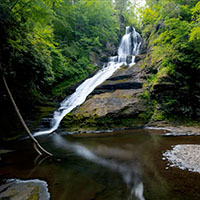Landscape photography for beginners: Sony Artisan Colby Brown on improving your images
posted Tuesday, September 7, 2021 at 10:30 AM EST

Sony Artisan Colby Brown partnered up with B&H to create a four-part video series aimed at beginning landscape photographers. The video series started in mid-August and wrapped up yesterday, so we've got all four of Brown's excellent videos to share with you today.
The first video covers the topics budding landscape photographers need to know to get started. In the video below, Brown talks about landscape photography itself and how to create impactful landscape images. He also shares what he thinks are the three pillars of a good landscape image: subject selection, depth and perspective.
The second video in Brown's series is focused on gear. What is the essential gear you need for landscape photography? A camera and lens, of course. As a Sony Artisan, Brown's camera bag is, unsurprisingly, full of Sony equipment, including full-frame Alpha mirrorless cameras and an assortment of G Master lenses. You can capture beautiful landscapes with many types of cameras from any standard brand, including compact and DSLR cameras. You also don't need a full-frame camera. As for lenses, a typical landscape lens is a wide-angle zoom lens, although you'll notice that Brown has a telephoto zoom lens, too, which can be an awesome lens for landscapes, too.
In addition to camera equipment, landscape photographers will want to have a sturdy tripod. You don't need to pay a lot of money to get a high-quality tripod, either. You can find great tripods for under $200. Brown highlights a specific tripod in his video, the Benro TMA38CL Long Series 3 Mach3 Carbon Fiber Tripod. It costs $450 and is very highly rated. Beyond a tripod, you'll also want filters, including neural density, graduated neutral density and circular polarizing filters. You can replicate the effect of a graduated ND filter when editing your photos, but there's no replacement for a polarizing filter when trying to reduce glare in your photos.
In the third video, we join Brown in the field to discuss how to compose landscape photos. He also talks about common mistakes you'll want to avoid. The foundation of a good landscape photo is a compelling subject, so you'll want to spend the time needed to make sure that you identify a strong subject and then you will build your composition around that subject.
What are some mistakes to avoid? While you want to have a strong subject in your photo, you don't want to spend all your time focused on a single image. Look around, see if you can find other potential photos in the area. Try different focal lengths and perspectives.
In the video below, Brown also discusses camera settings, including how to select the right shutter speed and aperture for your landscape photos. Every scene is different, but there are some guiding principles you can use to inform your photography.
At this point, we've learned what landscape photography is, what gear we need and how to capture great images. The final step, and the focus of Brown's final video in the series, is photo editing. Below, Brown discusses how you can use Adobe Lightroom and Adobe Photoshop to edit your landscape photos.
Covered topics include picking out your best shots in Lightroom, making basic edits, creating composites, using Adobe Camera Raw, how to adjust colors using hue/saturation/luminance sliders, making spot edits and more.
To see more of Colby Brown's excellent photography, head over to his website and follow him on Instagram.
(Via B&H)